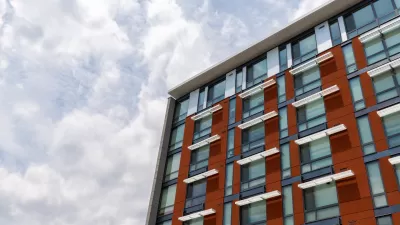A relative lack of conversions from office to residential—the adaptive reuse model driving the housing market in many urban areas—makes the Washington, D.C. region a perfect place to study the factors that make or break an adaptive reuse proposal.

Cities around the country have spent recent years converting old office buildings into residential uses. The wave of adaptive reuse projects in some local cases could be credited with creating entirely new residential neighborhoods.
"Yet despite considerable media coverage, office conversion has been comparatively limited in greater Washington," according to Payton Chung.
Chung cites research from a 2016 report by Jones Lang LaSalle that counted only 26 conversion projects in Washington, D.C.; Montgomery County, Fairfax County, and Arlington County combined. The whole D.C. region has completed "scarcely more" office conversions than the city of Baltimore alone.
According to Chung, the reasons for D.C.'s resistance to office conversions fit into two broad categories: a relatively healthier office market and a lack of specific incentives adaptive reuse. That could be about to change, however, as "Fairfax County and Montgomery County have recently commissioned studies to investigate office building adaptive reuse." In studying the issue, a couple of useful themes have emerged that can help determine the feasibility of adaptive reuse in other contexts, namely, location, price, and layout.
Chung's article goes into a lot more detail on each of those three considerations.
FULL STORY: Not every obsolete office building is cut out to become apartments

Trump Administration Could Effectively End Housing Voucher Program
Federal officials are eyeing major cuts to the Section 8 program that helps millions of low-income households pay rent.

Planetizen Federal Action Tracker
A weekly monitor of how Trump’s orders and actions are impacting planners and planning in America.

Ken Jennings Launches Transit Web Series
The Jeopardy champ wants you to ride public transit.

Rebuilding Smarter: How LA County Is Guiding Fire-Ravaged Communities Toward Resilience
Los Angeles County is leading a coordinated effort to help fire-impacted communities rebuild with resilience by providing recovery resources, promoting fire-wise design, and aligning reconstruction with broader sustainability and climate goals.

When Borders Blur: Regional Collaboration in Action
As regional challenges outgrow city boundaries, “When Borders Blur” explores how cross-jurisdictional collaboration can drive smarter, more resilient urban planning, sharing real-world lessons from thriving partnerships across North America.

Philadelphia Is Expanding its Network of Roundabouts
Roundabouts are widely shown to decrease traffic speed, reduce congestion, and improve efficiency.
Urban Design for Planners 1: Software Tools
This six-course series explores essential urban design concepts using open source software and equips planners with the tools they need to participate fully in the urban design process.
Planning for Universal Design
Learn the tools for implementing Universal Design in planning regulations.
Ada County Highway District
Clanton & Associates, Inc.
Jessamine County Fiscal Court
Institute for Housing and Urban Development Studies (IHS)
City of Grandview
Harvard GSD Executive Education
Toledo-Lucas County Plan Commissions
Salt Lake City
NYU Wagner Graduate School of Public Service





























